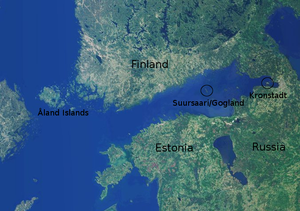Tanne Ost
| Operation Tanne Ost | |||||||
|---|---|---|---|---|---|---|---|
| Part of the Lapland War of World War II | |||||||
 Location of the Åland Islands, Suursaari, and Kronstadt. |
|||||||
|
|||||||
| Belligerents | |||||||
|
|
|
||||||
| Commanders and leaders | |||||||
| Captain Karl-Conrad Mecke |
|
||||||
| Strength | |||||||
| 2,700 |
|
||||||
| Casualties and losses | |||||||
| 153 KIA 1,231 POWs 3 landing crafts (F-822, F-866 & F-173) 3 patrol boats (B-1, B-31 & B-35) 1 minesweeper (R-29) 1 tugboat (Pernau) 2 Halftrucks, 1 light armoured car and a few trucks |
67 WIA 8 MIA 2 patrol boats (VMV 10 & VMV 14) |
||||||
Operation Tanne Ost ("Fir East") was a German operation during World War II to capture the island Suursaari (Swedish Hogland, Russian Gogland) in the Gulf of Finland before it could fall into Soviet hands. Suursaari was especially important because it worked as a lock in the Finnish Gulf guarding the minefields keeping the Soviet Baltic Fleet in Kronstadt.
Finnish preparations to separately conclude the war against the Soviet Union prompted Germans to prepare for such an eventuality. Furthermore, as the situation developed critical in mid-June 1944 during the initial successes of the Soviet Vyborg-Petrozavodsk Operation Germans placed the forces prepared for the operation into full readiness. German plans for both of the Tanne operations were planned alongside the Operation Birke, the German 20th Mountain Army's evacuation and on 5 July 1944, the Tanne operations were assigned solely to the Kriegsmarine. On 2 September 1944, Finland officially informed Germany of the coming cease-fire between Finland and the Soviet Union, which led to Hitler's orders to confiscate all Finnish shipping and to prepare for the Operation Tanne Ost. While the confiscation order was rescinded in order to facilitate the material transport related to Operation Birke, as Finnish authorities had prevented any ships from sailing from Finland to Germany, plans for capturing Hogland were kept in motion.
The operation was initially planned with another operation to capture the Åland Islands (Tanne West), which was not carried out both because the units reserved for the operation were already deployed to the Eastern Front and because Sweden had warned against operations in Åland.
On September 14, 1944, a first wave of 1400 men from both the Wehrmacht and the Kriegsmarine were loaded on ships in Tallinn. Before the assault the German commander tried to negotiate with the Finnish commander on Suursaari, as he had been led to believe from intelligence reports that the Finns might leave without resistance. At midnight, when a pair of Finnish VMV-class patrol boats were preparing to leave to transport a stranded German radio unit, a German minesweeper arrived at the docks on the eastern side of the island and demanded that the island surrender. When the demand was refused the Germans started to land troops which led to Finnish forces opening fire at 00:55 on 15 September 1944. German landing craft arrived at the docks forcing Finnish security force at the location to withdraw but not before torching the two trapped Finnish patrol boats (VMV 10 and VMV 14).
...
Wikipedia
